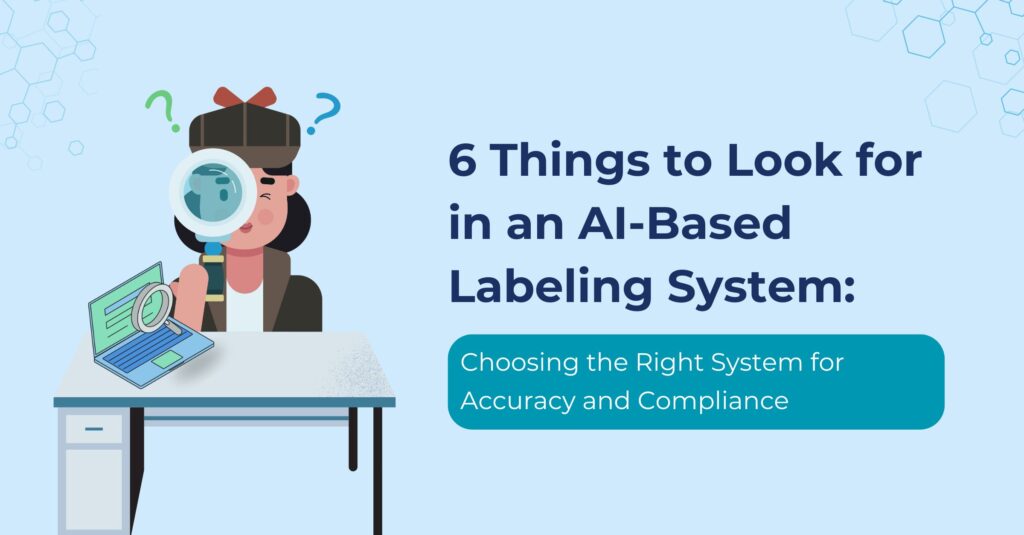
An effective AI-based labeling system can significantly reduce errors, save time, and adapt to evolving business needs – which is why it’s so important to choose the right one. In this post, we’ll go over exactly what you should look for when making this decision.
The way pharmaceutical labels are created is evolving, with AI-based systems offering new ways to achieve accuracy, efficiency, and compliance. However, not all AI labeling systems are created equal, and choosing the right one can make a significant difference in your operations.
So, before we explore what to look for, let’s define what we’re talking about.
What is AI-based labeling?
Unlike traditional labeling systems, which often rely on manual input, fixed templates, and repetitive processes, AI-based labeling leverages artificial intelligence to automate and optimize the creation, management, and compliance of product labels.
Structured content AI uses machine learning and natural language processing (NLP) to intelligently interpret, structure, and update labeling content, speeding up the process and achieving higher accuracy. This approach contrasts with systems that lack AI integration, which often struggle with scalability and may not easily adapt to evolving regulatory requirements.
6 Most Important Features in an AI-based Labeling System
The right system should not only meet your current needs but also be flexible enough to grow with your organization and adapt to changing regulations. To help you navigate this decision, we’ve put together a list of six critical features to consider when evaluating AI-based labeling solutions.
#1 – Compatibility with Existing Systems & Workflows
Selecting an AI-based labeling system that integrates with your existing systems and workflows is a critical factor for ensuring a smooth transition and ongoing efficiency. The goal is to find a solution that enhances rather than disrupts your current operations.
Data formatting is an important factor here. The AI system should be able to handle the data formats you currently use, whether they are proprietary or standard industry formats. This ensures that data can flow smoothly between systems without requiring extensive conversions or adjustments.
Workflow alignment is also crucial. The AI system should fit naturally into your established processes, reducing the need for significant changes or retraining. For example, if your current workflow involves specific steps or approvals, the new system should accommodate these steps or integrate into them. This minimizes disruptions and allows your team to adapt quickly.
#2 – Proven Track Record of High Accuracy in Labeling Tasks
Accuracy is a fundamental requirement for any labeling system, especially when dealing with critical data or regulatory compliance. An AI system with a demonstrated history of high accuracy can help prevent costly errors and ensure that all labeling meets the necessary standards. When choosing a system, be sure to:
- Look for case studies and testimonials: Seek out examples where the AI system has been successfully implemented in similar industries or for similar tasks.
- Evaluate error rates: Understand the system’s error rates in various labeling scenarios to determine if it meets your accuracy requirements.
- Review third-party evaluations: Independent assessments can provide unbiased insights into the system’s performance.
#3 – Intuitive Design That Requires Minimal Training
An AI labeling system’s usability is a fundamental aspect to consider because it directly impacts how quickly and effectively your team can adopt and use the technology. A user-friendly system minimizes the time and resources needed for training, allowing your team to focus on core tasks rather than struggling with new software.
The design of the system’s interface plays a significant role in its usability. An intuitive, clean, and logically organized interface helps users navigate the system effortlessly. This means that:
- The main dashboard should present key features and functions in a straightforward manner, with commonly used tools readily accessible. This reduces the time spent searching for functionalities andimproves overall efficiency.
- The system should provide a consistent user experience across different platforms and devices, such as desktops, tablets, and mobile devices. Consistent design and functionality across platforms help users transition smoothly between devices and maintain productivity without having to relearn processes.
#4 – Built-in Compliance with Global Regulatory Standards
Compliance with global regulatory standards is a non-negotiable aspect in label generation. Your AI-based system should come equipped with built-in compliance features that automatically align with the necessary regulations. The system should:
- Support multiple regulatory frameworks (like FDA, EMA, etc.)
- Have the ability to integrate ePI (Electronic Product Information) requirements into your content
- Regularly update to reflect the latest regulations
- Have reliable and precise translation capabilities
- Generate reports that meet compliance requirements for audits and inspections
#5 – Ability to Scale with Your Company’s Growth
Choosing an AI-based labeling system with robust scalability ensures it can adapt to your company’s evolving needs as it grows. With such a system, you should have the flexibility to either outsource conversions or implement an all-in-one solution, depending on your organization’s needs and resources.
- Outsourcing conversions allows you to benefit from specialized knowledge and resources without the need for significant investment in new technologies or additional staff. For example, you’ll be able to get submission-ready ePI outputs on-demand in days without changing anything in your workflow. This can be a great option for smaller companies and those who want to dip their feet in before getting in the deep end.
- Alternatively, an all-in-one solution provides a comprehensive approach to managing the entire labeling lifecycle. This type of system integrates the latest ePI FHIR (Fast Healthcare Interoperability Resources) and/or PharmaLedger formats with your existing systems, and handles everything from the creation and updating of labels to ensuring compliance, archiving, and more. For larger companies with robust product backlogs, implementing an electronic labeling solution can produce a higher ROI.
#6 – Comprehensive Support Services
When you invest in an AI-based labeling system, you should get access to comprehensive support and training.
Look for support services that offer a range of resources and assistance, including technical support to handle any immediate issues and training programs to enhance user proficiency. Additionally, services that include customization support and integration assistance can help tailor the system to fit your organization’s unique needs and ensure it works with your existing processes.
Conclusion
Ultimately, an ideal AI-based labeling system should align with your operational goals, provide the flexibility to handle growth, and ensure compliance with the latest regulatory standards. Take the time to assess your options thoroughly, and choose a system that will drive productivity, reduce costs, and help you stay ahead in the increasingly competitive market.
Want to implement a proven structured content AI management system and partner with a leader in pharmaceutical labeling? Contact Glemser today to get started.


